Tailoring Explosive Ordnance Risk Education:
How MAG Addresses Gender/Cultural Sensitivities and Local Risk-Taking
CISRThis article is brought to you by the Center for International Stabilization and Recovery (CISR) from issue 25.2 of The Journal of Conventional Weapons Destruction available on the JMU Scholarly Commons and Issuu.com.
By Sebastian Kasack [ MAG, Mines Advisory Group ]
The relevance of risk education is widely acknowledged as reflected in the Oslo Action Plan (OAP) with its distinct chapter on ‘Mine risk education and reduction’ and five explicit actions. Good risk education must be tailored. MAG’s experience delivering explosive ordnance risk education (EORE) in fourteen countries confirms the relevance of tailoring EORE to the local reality: to people’s risk taking behaviors, to the actual explosive ordnance (EO) threat, to seasonality, availability of people for risk education sessions, and approaches that respect gender and diversity and take conflict sensitivity into account.
EORE1 was first piloted in El Salvador in 1982, nearly forty years ago. The mine action sector knows that in order to effect lasting behavior change, a person needs to
- understand the threat
- recognize explosive devices
- differentiate between a dangerous and a safe or safer area
- understand what risk-taking behavior entails and its potential consequences
- know what to report and to whom when spotting EO
- choose actions that increase personal safety
- be empowered to assist others when encountering EO or an EO accident
This article discusses how Mines Advisory Group (MAG) tailors its EORE sessions in more than fourteen countries globally2 in accordance with the OAP (Actions #29 and #30), agreed to by the 164 States Parties to the Anti-Personnel Mine Ban Convention (APMBC) at the Review Conference in 2019.
OAP Action #29 calls to “provide context-specific mine risk education and reduction programmes to all affected populations and groups at risk. Ensure that such programmes are developed on the basis of a needs assessment, that they are tailored to the threat encountered by the population, and that they are sensitive to gender, age, disability and take the diverse needs and experiences of people in affected communities into account.”3
OAP Action #30 calls to “prioritise people most at risk by linking mine risk education and reduction programmes and messages directly to an analysis of available casualty and contamination data, an understanding of the affected population’s behaviour, risk pattern and coping mechanisms, and, wherever possible, anticipated population movements.”4
For EORE to resonate with persons living, visiting, or working in EO-affected areas, the messaging must be relevant, simple, accurate, accessible, and culturally-sensitive.
Tailoring EORE
Threat Encountered by the Population (OAP Action #29)
Tailoring EORE starts with understanding the EO threat; there is no need to learn about anti-vehicle mines or cluster munitions if there is no threat from these types of ordnance in a particular area. In initial visits to a new location, community liaison (CL) teams conduct EO contamination baseline assessments (CBAs) to gain an understanding of how the specific area was affected by conflict, what types of ordnance might be present, and the community’s exposure to the contamination. This information is then fed into the EORE process to begin tailoring messages and materials.
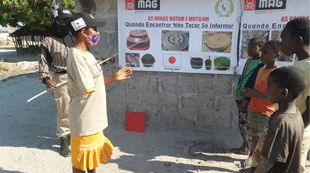
MAG Angola works with MAG’s only youth EORE trainee, Minga (eighteen years-old), who lost her sight and one arm due to a mine accident when she was six. While tailoring EORE is crucial to promote lasting behavior change, it is equally important to deliver these messages professionally, working through well-trained, gender-balanced teams (MAG or implementing partner staff), teachers (who are often local), and community focal points. At times, these educators include EO survivors delivering the life-saving messages.7 Image courtesy of MAG Angola.
MAG’s EORE is presented by CL staff who work closely with local clearance teams5 to ensure that the EORE delivered mirrors the actual threats beneficiaries are likely to encounter. In Angola, Iraq, South Sudan, and Bosnia and Herzegovina, MAG employs several deminers who were part of the forces that laid mines during conflict. CL teams use this first-hand knowledge of the ordnance deployed along with minefield locations, patterns, and tactics to tailor the EORE content to the local threat. These close relationships between technical and CL staff guarantee that EORE is tailored to the local threat.
In any given country, the EO threat can evolve over time and EORE therefore must adapt to reflect the realities on the ground. In northeast Syria, MAG’s initial intervention came on the heels of an Islamic State of Iraq and Syria (ISIS) retreat from the area leaving behind mostly improvised mines, abandoned improvised explosive devices (IEDs), and booby-traps. However, the latest round of fighting resulted in large-scale displacement and more widespread unexploded ordnance (UXO) contamination. In Iraq, contamination has come in waves: the Iran-Iraq War (1980–1998), Operation Desert Storm, the conflict beginning in 2003, and the rise and fall of ISIS. Throughout, materials and approaches were adapted to reflect the changes in the EO threat.
Gender, Age, Disability, and Culture and Taking into Account the Diverse Needs and Experiences of People in Affected Communities (OAP Action #29)
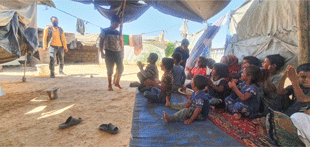
In Syria, MAG’s CL teams use age-specific EORE by incorporating games into sessions to increase children’s participation and maintain their interest. Image courtesy of MAG Syria.
The exposure to EO contamination and the risks taken by a ten-year-old schoolgirl are necessarily different than those of a fifty-year-old hunter or a twenty-five-year-old farmer.6 In addition to developing EORE messages that speak directly to the needs and experiences of different groups, EORE sessions can be planned to target those specific subpopulations and the people who have the most influence over their behavior (e.g., adolescent boys, male community leaders, women’s rights organizations, etc.). To this end, MAG undertakes gender and diversity analyses to inform its EORE programming.
In Nigeria, MAG delivers EORE to the general at-risk population, applying the age and gender lens to target adult men and women (age 18+), male and female teenagers (12–17), and younger boys and girls (6–11). To help tailor the messages to specific audiences, the sessions begin with a dialogue to gain an understanding of the participants’ knowledge about the area’s background, community composition, history, conflict impact, humanitarian challenges, types of contamination, etc.
In South Sudan, MAG’s operations demonstrate that men are more difficult to reach with risk education than women, girls, and boys since they attend community sessions less often. As in other countries globally, men are statistically more likely to be killed or injured by EO than women; therefore, MAG’s CL teams make a concerted effort to schedule risk education session locations and times to match the schedules demanded by male-dominated livelihoods. Accordingly, sessions are now held at cattle camps and during periods between grazing.
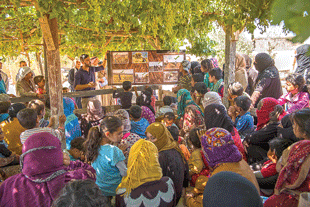
A village in al-Hassakah Governorate in Syria. Defensive minefields left behind after the conflict with ISIS led to high accident and casualty rates, with children figuring highest. On average ten persons (mostly boys) lost their lives per village due to EO, including some booby-traps. EORE sessions were tailored to address the threat from improvised mines and booby-traps. Image courtesy of MAG Syria.
Tailoring EORE to be inclusive for persons with disabilities is still an area MAG is working to improve. Persons with visual impairments miss out on key content in standard formats, such as banners/visual images, while persons with auditory (hearing) impairments miss out on the live presentations.
In northeast Syria, MAG’s CL teams provided four EORE sessions in 2018 to children at New Horizons Association learning center with the support of staff who use sign language. Jawahar Abdo, a hearing impaired seventeen-year-old girl, participated. One of her family members had lost his life in a mine accident when he tried to escape from Ar-Raqqa city when it was under ISIS control. Jawahar notes
One month ago, I attended one risk education in the camp where I live now, but I did not understand anything because they were speaking orally but now by the cooperation between you and our teacher using sign language, the session was perfect. I and my mates believe that we have understood everything from you; now I can distinguish between mines and other dangerous items, I know what a mine is, how to be safe and whom to inform; when I go back to my home in Ar-Raqqa, I will apply all things that you taught us today, it was great, thank you.
Analysis of Available Casualty Data (OAP Action #30)
In addition to understanding the threat itself, understanding and analyzing EO incidents and accidents8 is key to tailoring EORE. A number of lines of inquiry can contribute to tailored EORE plans and are detailed in Figure 1. MAG teams apply a gender- and age-sensitive lens when analyzing questions relating to casualty data.9
Accident data relevant to EORE:
- Age/gender of victim
- Accident location
- Activity at time of accident
- Knowledge/lack of knowledge of victims to the threat, including whether the victim had attended EORE
In Somalia from 1999 to 2019, EO caused 3,313 casualties. Since 2015, children represent 78–88 percent of all known casualties.10 As recently as August 2021, two boys in central Somalia found a hand grenade in a field and were injured when it exploded.11 Tailoring EORE to reach children is a challenge when schools are closed due to the COVID-19 pandemic. Even when schools are in session, it is more difficult to reach girls due to low school enrollment rates.12
In South Sudan, where EO accounted for 40 percent of the conflict-related casualties among children in 2020,13 reaching children has been a priority. MAG has recently met with the United Nations Children’s Fund (UNICEF) to explore synergies and develop child-friendly messaging in schools and household sessions.
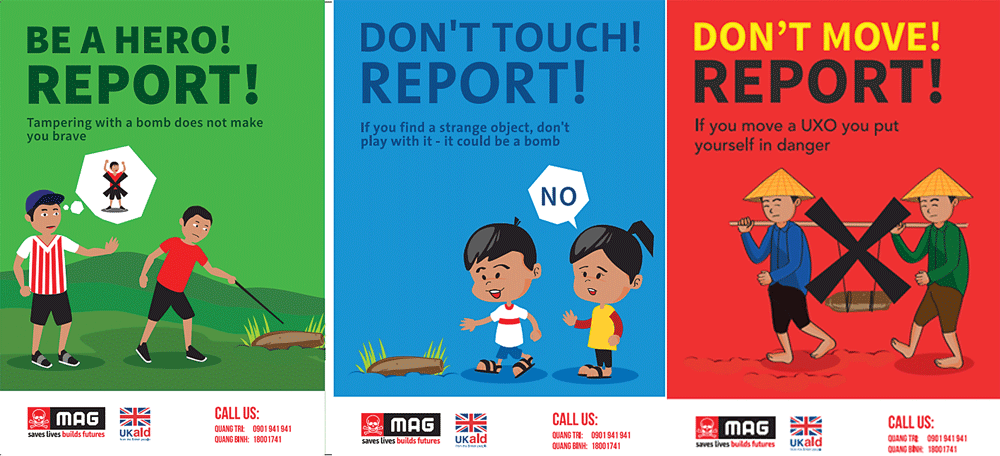
MAG Vietnam EORE material and key messages tailored to farmers, children, and youth. Hotline numbers are regularly used by locals. Figures courtesy of MAG.
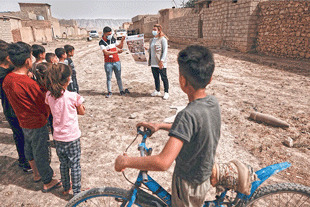
In May 2021, MAG’s CL team received a call reporting a bomb in a Yazidi village in Sinjar, Iraq. When they arrived to assess the area, they were shocked to find a group of children playing with an unexploded artillery shell in the street. The children believed the shell to be harmless as they had been playing with it for a few days and nothing had happened. The shell was in fact fuzed. Any slight knock could have caused it to detonate.
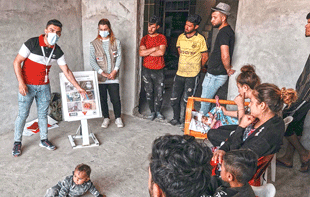
They had been unbelievably lucky. Kheder, aged eleven, said “I have seen a bomb in a house just over there. I know of other bombs around here as well.” The team immediately delivered rapid response risk education to the children, using posters and flyers to explain the danger and reported the dangerous items to MAG’s technical team. The CL team also visited the families of the children playing with the shell. One of the mothers said, “We came back to the village last September because our life was difficult—there was no work. Our house was damaged by ISIS, but we are rebuilding it. But we are still afraid because the areas around us are not safe. And now we find out that the children were playing with a live bomb.”
MAG is working to teach the families in this village how to stay safe until all the unexploded bombs and landmines are cleared. As one of the biggest Yazidi villages in Iraq, it has suffered horrific attacks during the conflict and large areas remain contaminated.
|
Groups at risk/ |
Reasons for risking exposure and vulnerability to explosive ordnance |
|---|---|
|
Nomads and herders |
Considered to be at risk because of their activities, through which they often encounter EO, nomads and herders often find themselves trapped in dangerous areas. Many nomads, their families, and their livestock become EO victims. |
|
Truck/bus drivers and travelers in the desert |
Drivers and travelers sometimes get lost in the desert. If they are not aware of explosive devices, warning signs, danger zones, and how to adopt safe behavior, they can be the victim of accidents. |
|
Traditional route tracking guides |
Given the heavy EO contamination, people who specialize in recognizing desert routes are helping travelers. These people are an at-risk group if they fail to identify danger zones and signs and can benefit greatly from improving their knowledge of EO safe behaviors. Guides can pass on key EORE messages to travelers who have not previously attended any EORE sessions. |
|
Women and girls |
Women during domestic activities, especially when foraging for firewood, water, and dates, may move in or near dangerous areas and encounter EO. Some become victims due to handling EO. In Kalait, collecting wood for profit is very widespread. |
|
Children |
Children are at risk because of their curiosity to tamper with EO. A fairly large number of children in the intervention area herd livestock in the grazing areas. Even children going to school have encountered EO around or along the paths leading to schools. |
|
Community leaders |
By strengthening their capacities on EORE messages, community leaders can disseminate these messages to travelers to allow them to stay away from hazardous areas, stay safe during their journey, and to report the EO identified during their trip. |
|
Men and boys |
Men engage in the exploitation of natural resources such as natron14 and in breeding livestock and growing dates. During these activities, they can be exposed to EO. |
|
Figure 2. An example of MAG’s CL team assessment for the province of Ennedi Ouest, Chad, which relates how these groups are exposed to explosive devices taking a gendered approach. |
|
Burma/Myanmar. During the COVID-19 pandemic, MAG developed five videos in Jinghpaw, Shan, and Burmese languages to raise awareness about the dangers of landmines/EO and safe behaviors among communities in Kachin and northern Shan states, in partnership with Sin Sar Bar, a local social media enterprise.15
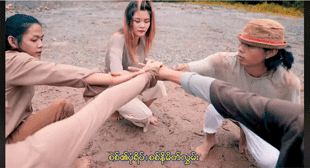
Video still from the BOMB video created by MAG Myanmar. The video disseminates EORE safety messages featuring contemporary dance and spoken word poetry written in local languages. Image courtesy of MAG.
Two videos were made with local celebrities who had a broad appeal within their respective ethnic groups: one video featured the Kachin celebrity Daw K Jar Nuu and the Shan musician Ko Han Tun. They were identified because of their cross-generational appeal, which would ensure that a broader audience clicked on the videos and listened to the key safety messages.
Another set of videos was made with the dance group Revolution Dance Crew to appeal to a younger audience of teenagers and millennials. The Revolution Dance crew designed a modern choreography inspired by key EORE safety messages, which was filmed in a natural location so that it would resonate with young rural audiences. Spoken word artists provided a unique voiceover in the form of poetry that incorporated key EORE safety messages matched to the interpretive dance. By working with a set of ethnically diverse local poets, MAG ensured that the content was tailored and accessible to different ethnic groups living in Kachin and Shan States.
The campaign was launched on MAG Myanmar’s Facebook page in mid-September 2020 and ran until the end of November 2020. Combined, the videos reached more than a million people, with over 120,000 engagements. The videos have also been shared with CL staff and community volunteers who have used them as additional material when delivering EORE to communities.
Zimbabwe. In Zimbabwe’s mine-affected communities, women’s roles include collecting firewood, cultivating land, cross-border trading, and searching for water, among others. Due to these gendered roles, women acquire unique knowledge about mines and other EO. To obtain this information, MAG works in mixed and segregated settings, as appropriate, to ensure that safety messages address risk attitudes and practices while proposing realistic solutions. MAG plans to ask mothers or wives of victims/
survivors to pass on effective and credible EORE messages. Same-sex facilitators, peers, and respected authorities such as police or army personnel are useful in conveying safety messages to at-risk communities.
Understanding the Affected Population’s Behavior, Risk Pattern, and Coping Mechanisms (OAP Action #30)
EORE needs assessments can be large and costly undertakings, which can include Knowledge, Attitude, Practice/Belief (KAP/B) studies integrating quantitative and qualitative approaches.16 Less cumbersome and costly approaches are systematic focus group discussions (FGDs) prior to the onset of an EORE campaign.17
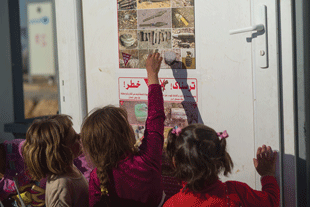
Internally displaced persons (IDP) camp in Dohuk, Iraq. Yazidi children are recognizing EO they encountered while they fled their home areas. CL teams in Duhok generally focus on cluster munitions and conventional mines, but include information on improvised mines where relevant for IDPs from Ninewa and other governorates. Image courtesy of Sean Sutton/MAG.
MAG’s CL teams carry out a CBA and/or FGDs prior to an EORE campaign with different segments of the population (community leaders, civil society organization leaders, groups of women, children, victims/survivors of explosive devices, hunters, shepherds, etc.). The discussions center around the topic of EO and help the CL teams to understand the types of explosive devices present in the community, the extent of the contamination, differing impacts of EO contamination on the community, and the behaviors the community has adopted in response to this threat. Information gathered in the CBA guides the risk education strategy through prioritization and helps to identify the most relevant messages for each community and risk group.
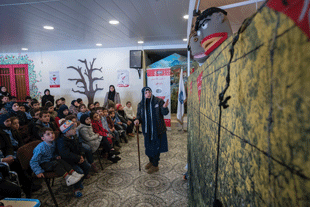
Everyone has the right to access life-saving information. A MAG CL team delivers an EORE puppet show to children with disabilities in their school in Lebanon, February 2019. Image courtesy of Sean Sutton/MAG.
MAG teams aim to reach specific risk-taking groups such as shepherds (mostly boys/young men), scrap-metal dealers, or scrap collectors. Understanding the population also requires understanding their daily, weekly, and seasonal routines:
- During which months of the year is risk-taking behavior occurring?
- When is the best time to reach specific populations (e.g., children, adolescents, women, and men)?
- Where is it best to reach them (e.g., at home, in the fields, hunting hut, etc.)?
Addressing existing coping mechanisms can be tricky, as they usually involve risk-taking behavior such as moving explosive devices, including mines. Coping mechanisms include passing the risk on to others who may be better equipped (village deminers/ex-soldiers, etc.) or persons who take the job due to financial need, such as seasonal workers. Discussing such behavior during FGDs is one way to address these issues. However, if there is no fast and reliable way of removing the threat via EO disposal or clearance, the population will continue to rely on its coping mechanisms despite being aware of the associated risks. Therefore, an integrated EORE response aims to link mine action with community development workplans and community investment programs.18
Anticipated Population Movements (OAP Action #30)
EO contamination threatens millions of people in post-conflict environments. Populations fleeing war, settling in camps near EO contamination, as well as those deciding to return to or check on their homes, may face life-threatening situations that were not present when they were originally displaced. For displaced persons, EORE must be tailored according to the target audience’s intentions for movement and/or resettlement.
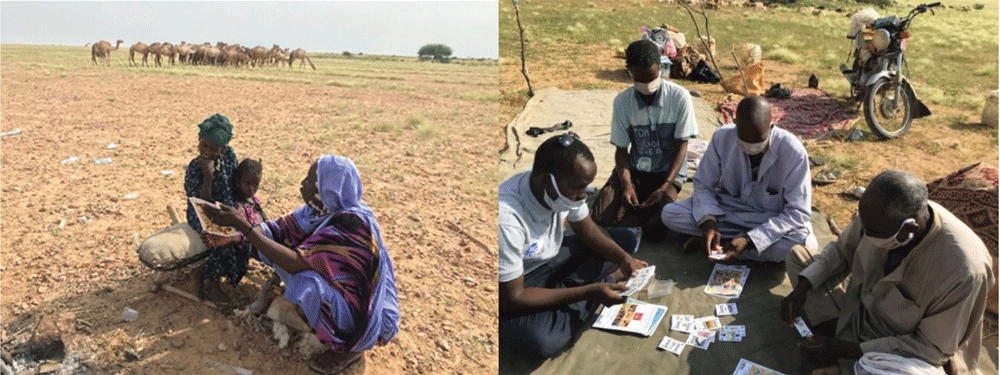
In Chad it is difficult to reach those most at risk, including nomads and herders, because of their mobility. MAG’s CL teams travel several miles and start early in the morning when these populations are more willing to devote time to MAG’s EORE sessions. Here, MAG conducts a risk education session for the benefit of nomads who camped 25 km from Kalait in the province of Ennedi West in Chad on 16 September 2020. Images courtesy of MAG.
In Iraq in 2020, MAG CL teams received news of people returning to a village with known EO contamination; however, CL teams could not deploy to the area to conduct EORE sessions due to COVID-19 restrictions. As an emergency response, EORE was conducted by phone for more than 1,000 families based on a ten-minute script tailored to the specific contamination of the village to which they were returning.
MAG Iraq and Syria collaborated in preparing EORE materials for Syrians arriving in Kurdistan Region of Iraq (KRI) following the start of military action in northeast Syria on 9 October 2019. A total of 21,540 Syrians crossed into KRI;19 the expectation was that many would return to northeast Syria soon after. MAG produced photographs indicating how to recognize dangerous areas and warning signs, and used the local dialect for messaging that is used in the areas to which they would be returning after acute conflict subsided.
Another tailored approach, institutional EORE, involves reaching out to institutions in line with their work/activities and how the EO contamination may affect them. For example, the teams in Nigeria conduct sessions for community and IDP camp leaders, camp committees, women leaders, service providers, government officials, and aid workers.
Security Context and Applying Conflict Sensitivity
EORE during and post-conflict addresses a sensitive subject, including the laying of landmines and improvised devices, setting up booby-traps, etc. However, anyone with this type of information may be looked upon with suspicion and receive an unwanted visit by intelligence services. Therefore, both educators and their audiences need to be protected from harm. How materials are designed, what questions are asked during sessions, and how messages are delivered make a difference. Someone who reports the location of EO may face serious repercussions. However, excluding the entire subject of improvised mines, for example, is also not the right answer. Conflict-sensitive programming of EORE is required in such circumstances: whereas teams should not ask community members to report improvised mines to the authorities, asking them to report UXO is fine. Moreover, CL teams should encourage community members to alert their family members, neighbors, and visitors.
Challenges Encountered when Tailoring EORE
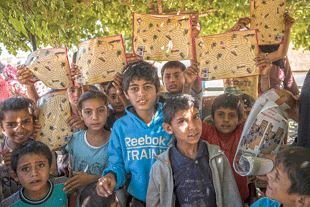
Children share materials with their parents and siblings, thereby multiplying the learning effects. Following the session, these children know the hotline number by heart.
As noted previously, tailoring requires understanding the EO threat, risk-taking behavior, and the cultural and environmental contexts of at-risk groups. When setting up an EORE program, this information is likely not available and, especially in emergency settings, there is insufficient time to undertake a thorough EORE needs assessment.20 For example, EO accident and casualty data continue to be hard to obtain in many countries and/or it does not provide sufficient detail. Nevertheless, delaying lifesaving EORE is not an option.
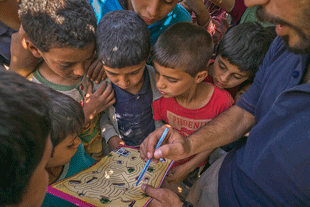
Children use EORE materials that show how to avoid mines and other EO. It is essential to field test new materials, messages, and approaches when creating and delivering EORE.
The solution is to identify as much relevant information as possible, and to start gathering data from the onset. Key informant interviews and FGDs can be done immediately to help shape the EORE response. Regular internal and external quality assurance will reveal weaknesses in the EORE approach, delivery, messaging, and materials/means used. In such a scenario, teams should schedule a review and redesign the approach once sufficient experience implementing EORE has been gained. Material design and messaging is usually controlled by the national mine action authority (NMAA) or a UN organization.21 While controlling EO-safety messages and materials used in a given country is useful, messages must be coherent across the sector and materials must fulfil minimum requirements. However, the control can be too rigid and/or too time consuming to allow for the timely adaptation and tailoring of messages, materials, and approaches. Good coordination and collaboration across the mine action sector and among EORE managers and operators help minimize hurdles in reviewing and adapting delivery. Having regular technical working group meetings has proven beneficial if well-prepared and actions are monitored. Incorporating EORE into the quality management undertaken externally by the NMAA and/or United Nations and other organizational bodies also assists in strengthening the capacity of the staff assessing the work of EORE operators and reaching a common understanding of what entails best practice.
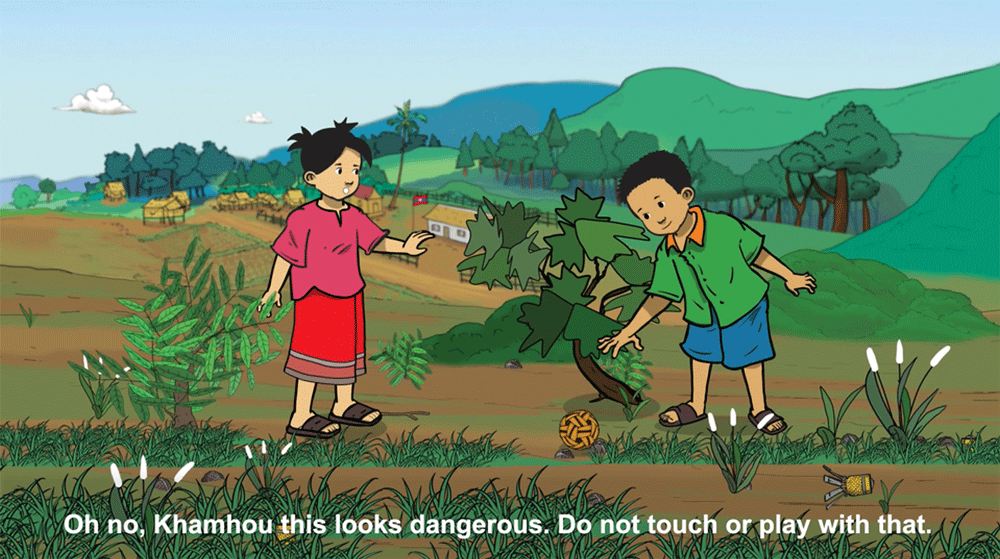
Video still from MAG’s animated video from Lao PDR in which EORE material is tailored for children.Image courtesy of MAG.
Conclusion
EORE saves lives but needs to be done well to resonate with people so that it leads to safe behavior when confronted with EO contamination. The OAP (for the period 2019–2024) stresses the need to tailor EORE approaches, messages, and means. MAG’s experience delivering EORE in fourteen countries confirms the relevance of tailoring EORE to the local reality: i.e., people’s risk-taking behaviors, the actual EO threat, seasonality, availability of people for EORE, and approaches that respect gender and diversity and take conflict sensitivity into account.
Acknowledgements
The author would like to thank his colleagues from fourteen MAG programs worldwide for their contributions to this article.
Sebastian Kasack
Senior Community Liaison Advisor
MAG (Mines Advisory Group)
 Sebastian Kasack has been working in the humanitarian mine action field for twenty-five years with NGOs, the United Nations, and as a consultant. Since 2016 he is the Senior Community Liaison Advisor for MAG (Mines Advisory Group). Kasack holds a master’s degree in Geography from the University of Bonn and a postgraduate degree on Developing Countries from the Swiss Federal Institute of Technology, Zurich. He is also a certified mediator and gained an advanced course certificate on conflict transformation (Bern). From 2019 to 2021, he was co-chair of the EORE Advisory Group for MAG.
Sebastian Kasack has been working in the humanitarian mine action field for twenty-five years with NGOs, the United Nations, and as a consultant. Since 2016 he is the Senior Community Liaison Advisor for MAG (Mines Advisory Group). Kasack holds a master’s degree in Geography from the University of Bonn and a postgraduate degree on Developing Countries from the Swiss Federal Institute of Technology, Zurich. He is also a certified mediator and gained an advanced course certificate on conflict transformation (Bern). From 2019 to 2021, he was co-chair of the EORE Advisory Group for MAG.

